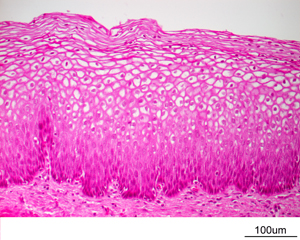
Abnormal pre-cancerous cells in cervical tissue Image: CMSP / J.L. Carson/Getty
Two studies out this week indicate that human papillomavirus (HPV) screening may be a more effective way than conventional pap smears to identify pre-cancerous cells, enabling women to intercept cervical dysplasia before it potentially develops into cancer.
A study of more than 58,000 women between the ages of 30 to 60 participating in a routine cervical cancer screening program in Finland suggests that testing for HPV is more effective at identifying pre-cancerous cells than pap smears. The study, published in the British Medical Journal, indicates that HPV tests are better able to pick up serious pre-cancerous lesions on the cervix, known as cervical intraepithelial neoplasia (CIN III). While, in this study few women in either the HPV screening or pap smear groups went on to develop cervical cancer in up to five years of follow-up, the researchers say that the findings are still important to furthering cancer prevention efforts in light of the “the high probability of progression of
CIN III lesions in women aged [35 and older].”
Meanwhile, a study of 11,000 women published in the British Journal of Cancer found that women who tested negative for HPV were less likely to go on to develop precancerous cells or cervical cancer than those who had negative pap smear results, Reuters reports. Researchers say the findings indicate that HPV screening is more effective, and could potentially enable women to be screened less frequently. As Jack Cuzick, an epidemiologist at the University of London and an author of the study told Reuters: “Using HPV testing as the primary screening method for cervical cancer would not only mean women could be screened less often but it would also mean efficiency savings.”
This latest research adds to a 2009 study of more than 130,000 women in India showing that HPV screening was more effective at preventing or routing out cervical cancer than either pap smear or another method known as visual inspection of the cervix after application of acetic acid (VIA).

